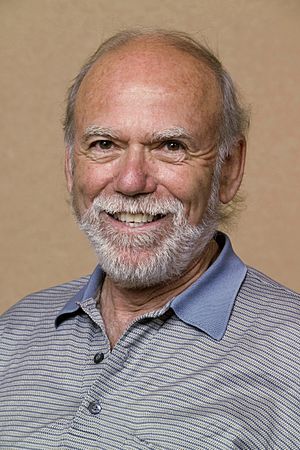Barry Barish facts for kids
Quick facts for kids
Barry Barish
|
|
|---|---|

Barish in 2005
|
|
| Born |
Barry Clark Barish
January 27, 1936 Omaha, Nebraska, U.S.
|
| Education | University of California, Berkeley (BA, PhD) |
| Spouse(s) | Samoan Barish |
| Children | 2 |
| Awards |
|
| Scientific career | |
| Fields | Physics |
| Institutions | University of California, Riverside Stony Brook University California Institute of Technology Sapienza University of Rome |
| Thesis | A study of the reaction negative pion plus proton going to negative pion plus neutral pion plus proton at 310 and 377 MEV (1962) |
| Doctoral advisor | A. Carl Helmholz |
| Doctoral students | Kate Scholberg |
Barry Clark Barish (born January 27, 1936) is an American scientist who won the Nobel Prize in Physics. He is a professor and a leading expert on gravitational waves, which are invisible ripples in space.
In 2017, Barish, along with Rainer Weiss and Kip Thorne, won the Nobel Prize. They were awarded for their amazing work on the LIGO detector, a special machine that was able to "hear" gravitational waves for the first time. This discovery proved a prediction made by Albert Einstein about 100 years earlier.
About his work, Barish said, "I didn't know if I would succeed. I was afraid I would fail, but because I tried, I had a breakthrough."
He has taught at several universities, including the California Institute of Technology, the University of California, Riverside, and Stony Brook University.
Contents
Early Life and School
Barry Barish was born in Omaha, Nebraska. His grandparents were Jewish immigrants from an area in Europe that is now part of Belarus. When he was a boy, his family moved to Los Angeles, California.
He was always interested in science. He went to the University of California, Berkeley, where he earned a bachelor's degree and a Ph.D. in physics. In 1963, he began his long career as a scientist and professor at the Caltech.
Scientific Discoveries
Barish has led several major experiments that have helped us understand the universe in new ways.
Listening to the Universe with LIGO
Barish's most famous work was with the Laser Interferometer Gravitational-wave Observatory (LIGO). In 1994, he became the main scientist for the project. He helped get the money to build two huge detectors in the United States, one in Louisiana and one in Washington state.
These detectors are giant L-shaped tunnels with lasers inside. They are built to detect tiny vibrations in space called gravitational waves. These waves are created by huge events in space, like two black holes crashing into each other.
On September 14, 2015, LIGO detected gravitational waves for the very first time. The waves came from two massive black holes that had merged together far away in space. This was a historic moment for science. It was the first direct proof that gravitational waves exist and the first time anyone had ever seen black holes merge.
Studying Tiny Particles
Before his work with LIGO, Barish studied the tiny particles that make up everything. In the 1970s, he did experiments at Fermilab using beams of particles called neutrinos. His work helped show how the smallest particles, called quarks, are inside protons and neutrons.
In the 1980s, he led an experiment called MACRO in a cave in Italy. This experiment searched for rare particles and also studied neutrinos coming from space. The results from MACRO helped prove that neutrinos have mass, which was a very important discovery.
Planning for the Future
From 2005 to 2013, Barish led the worldwide design team for the International Linear Collider (ILC). The ILC is a planned next-generation particle accelerator. Scientists hope it will help them discover even more about the universe, working alongside other powerful machines like the Large Hadron Collider at CERN.
Awards and Recognition
For his amazing contributions to science, Barry Barish has received many awards.
- Nobel Prize in Physics (2017): He shared the prize for his key role in LIGO and the discovery of gravitational waves.
- National Medal of Science (2023): This is one of the highest honors for a scientist in the United States. He received it from the President at the White House.
- Henry Draper Medal (2017): For his leadership and design work on LIGO.
- Princess of Asturias Award (2017): A major international award for scientific research.
- Enrico Fermi Prize (2016): For his work in creating the LIGO scientific team and solving difficult problems that led to the discovery.
He has also received honorary degrees from universities around the world, including in Italy, Scotland, and Bulgaria.
Family
Barry Barish is married to Samoan Barish. They have two children, Stephanie and Kenneth. Their son, Kenneth Barish, is also a professor of physics. They have three grandchildren.
See also
 In Spanish: Barry C. Barish para niños
In Spanish: Barry C. Barish para niños
- List of Jewish Nobel laureates


